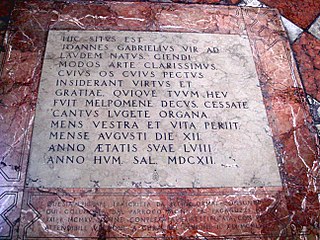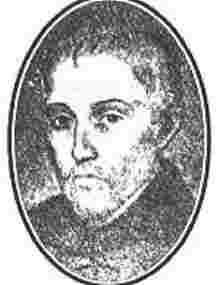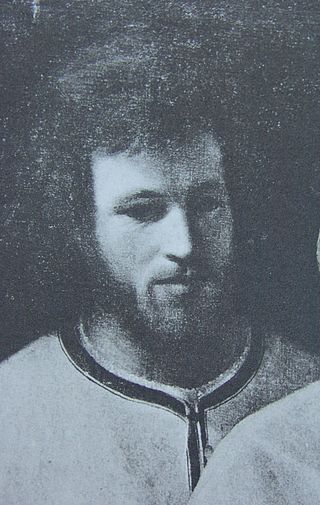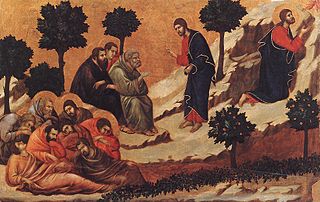
Giovanni Battista Draghi, often referred to as Giovanni Battista Pergolesi, was an Italian Baroque composer, violinist, and organist. His best-known works include his Stabat Mater and the opera La serva padrona. His compositions include operas and sacred music. He died of tuberculosis at the age of 26.

Giovanni Gabrieli was an Italian composer and organist. He was one of the most influential musicians of his time, and represents the culmination of the style of the Venetian School, at the time of the shift from Renaissance to Baroque idioms.

Tomás Luis de Victoria was the most famous Spanish composer of the Renaissance. He stands with Giovanni Pierluigi da Palestrina and Orlande de Lassus as among the principal composers of the late Renaissance, and was "admired above all for the intensity of some of his motets and of his Offices for the Dead and for Holy Week". His surviving oeuvre, unlike that of his colleagues, is almost exclusively sacred and polyphonic vocal music, set to Latin texts. As a Catholic priest, as well as an accomplished organist and singer, his career spanned both Spain and Italy. However, he preferred the life of a composer to that of a performer.

Miserere is a setting of Psalm 51 by Italian composer Gregorio Allegri. It was composed during the reign of Pope Urban VIII, probably during the 1630s, for the exclusive use of the Sistine Chapel during the Tenebrae services of Holy Week, and its mystique was increased by unwritten performance traditions and ornamentation. It is written for two choirs, of five and four voices respectively, singing alternately and joining to sing the ending in 9-part polyphony.

Giacomo Antonio Perti was an Italian composer of the Baroque era. He was mainly active at Bologna, where he was Maestro di Cappella for sixty years. He was the teacher of Giuseppe Torelli and Giovanni Battista Martini.

Philippe Verdelot was a French composer of the Renaissance, who spent most of his life in Italy. He is commonly considered to be the father of the Italian madrigal, and certainly was one of its earliest and most prolific composers; in addition he was prominent in the musical life of Florence during the period after the recapture of the city by the Medici from the followers of Girolamo Savonarola.
Jean Mouton was a French composer of the Renaissance. He was famous both for his motets, which are among the most refined of the time, and for being the teacher of Adrian Willaert, one of the founders of the Venetian School.
Pomponio Nenna was a Neapolitan Italian composer of the Renaissance. He is mainly remembered for his madrigals, which were influenced by Gesualdo, and for his polychoral sacred motets, posthumously published as Sacrae Hebdomadae Responsoria in 1622.
A responsory or respond is a type of chant in western Christian liturgies.

The Tenebrae Responsories by Tomás Luis de Victoria are a set of eighteen motets for four voices a cappella. The late Renaissance Spanish composer set the Responsories for Holy Week known as Tenebrae responsories. They are liturgical texts prescribed for use in the Catholic observances during the Triduum of the Holy Week, in the Matins of Maundy Thursday, Good Friday and Holy Saturday. The compositions were published in Rome in 1585.
Responsoria et alia ad Officium Hebdomadae Sanctae spectantia is a collection of music for Holy Week by Italian composer Carlo Gesualdo, published in 1611. It consists of three sets of nine short pieces, one set for each of Maundy Thursday, Good Friday and Holy Saturday, and a psalm and a hymn. The work was written for unaccompanied voices: two soprano parts, alto, two tenor parts, and bass.
Giuseppe Corsi Evangelisti (Vangelisti) better known as Gioseppe Corso Celani or Giuseppe Corsi da Celano, was an Italian composer of the Baroque era. He was mainly active at Rome, where he was Maestro di cappella. He was the teacher of Giacomo Antonio Perti and Petronio Franceschini.

Tristis est anima mea is the second responsory of the Tenebrae for Maundy Thursday. The Latin text refers to Christ's Agony in the Garden of Gethsemane, a part of his Passion.
Tenebrae responsories are the responsories sung following the lessons of Tenebrae, the Matins services of the last three days of Holy Week: Maundy Thursday, Good Friday and Holy Saturday. Polyphonic settings to replace plainchant have been published under a various titles, including Responsoria pro hebdomada sancta.